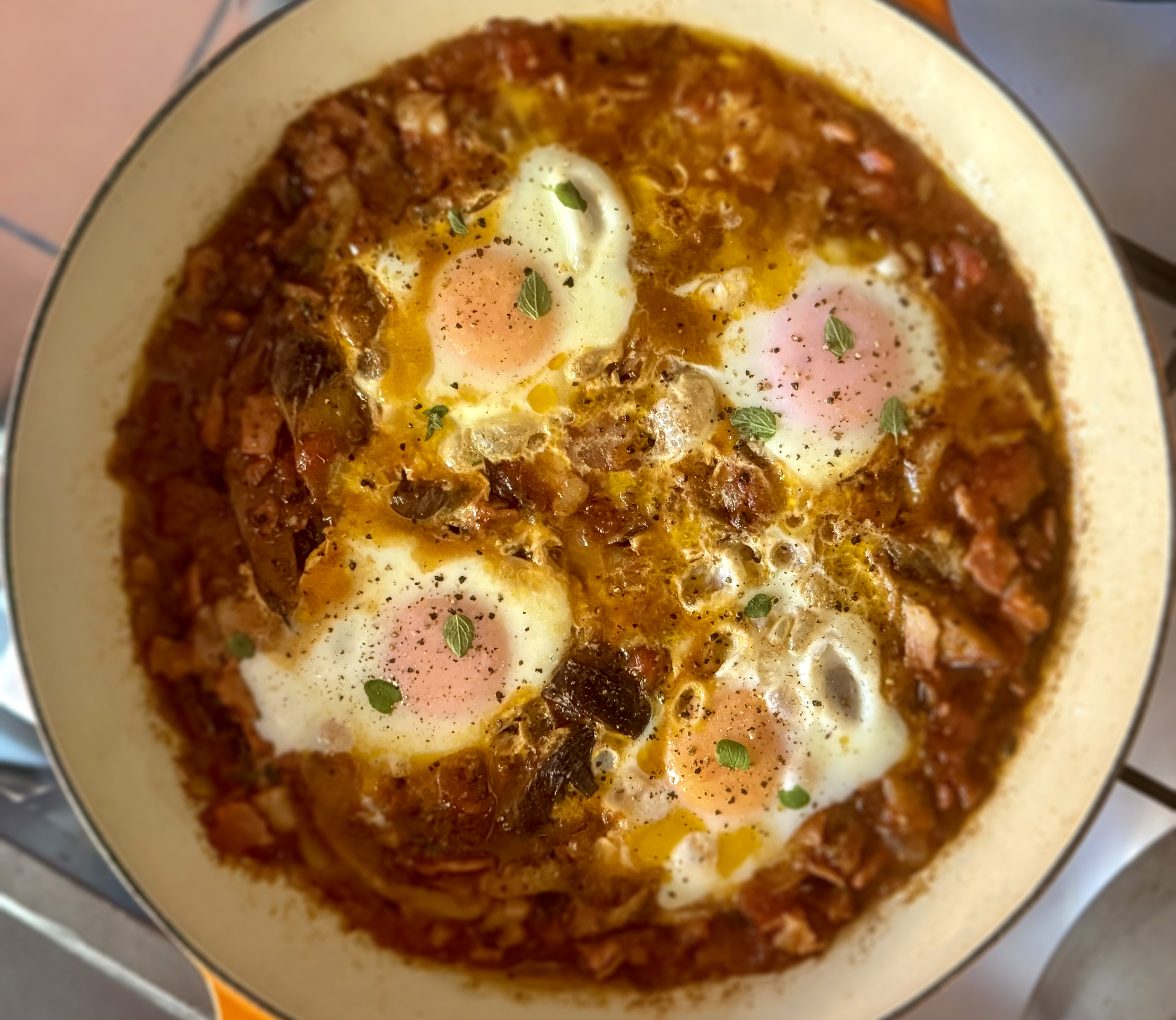In Maghrebi Arabic, a mixture of various dialects from this region of northern Africa, shakshuka simply means “mixed”, so it stands to reason that exactly what goes into the mix can be adapted by the person cooking the dish by that name.
Also spelt shakshouka or even (rarely) chakchouka/chakhchoukha, the word can also be a verb, in which case it means to bubble or sizzle, according to a reliable artificial intelligence friend of my acquaintance.
With this in mind, I was looking at the aubergines I had bought, without having had anything in mind other than they looked perfect and worth using in something or other. Somehow, shakshuka popped into mind.
A lot of people are puzzled by these fruits, but I’m more puzzled by their bewilderment. Call it a brinjal, eggplant, garden egg or “mad apple”, it falls into the nightshade family of edible fruits, and yes, they are fruit just as tomatoes are. They are also, technically, berries, given that they contain seeds and grow on flowering plants.
Of course, they’re infamously bitter, but olives are bitter too before we cure them and immerse them in oils and vinegars with aromatics to tame their sour edge.
And an aubergine, whatever you call it, is one of my favourite “fruit vegetables”, using the term to differentiate it from sweet fruits. Like tomatoes, we use these “fruits” in savoury cooking.
It would be a pity to leave tomatoes out of a shakshuka – in fact, without them I don’t think we’d be calling it that at all – so they are the base of this breakfast dish. I used onion as well, which isn’t always in a shakshuka, and very unusually I used garlic too. For reasons that should not need explaining, garlic does not normally appear in a breakfast dish.
And I decided to include bacon too, because it belongs on the breakfast table even if it is not usually in a shakshuka. This is an adaptation after all.
I used a little Rozendal fynbos vinegar for a sort of tart sweetness, rather than add a touch of sugar to offset the acidity of the tomatoes. And a cinnamon stick went in to add a bit of a Greek touch to it, along with oregano and thyme.
Of course, a shakshuka is finished by breaking eggs into wells and poaching them under a lid.
Tony’s shakshuka with aubergine and bacon
(Serves 2)
Ingredients
1 medium onion, thinly sliced
200 g back bacon, chopped
1 x 400 g can of chopped tomatoes and their juices
2 garlic cloves, finely chopped
1 large aubergine, sliced into thin strips
2 Tbsp Rozendal fynbos vinegar, or similar
1 cinnamon stick
1 Tbsp oregano dried or fresh
2 sprigs of thyme
Extra virgin olive oil – you’ll need plenty as brinjals soak it up
4 XL or jumbo eggs
Salt to taste
Black pepper
Thyme and/or oregano leaves to garnish
Method
Choose a broad pan with a lid such as a Le Creuset shallow casserole cast iron pan.
Fry the bacon bits in a little olive oil until crispy and reserve in a side-dish.
Fry the onion with the garlic and add to the bacon in the side-dish.
Add plenty more olive oil and fry the aubergine strips until soft. There’s no point in measuring it in this instance – if the strips of eggplant start to look dry, add more. They will turn pleasantly golden brown at their edges when soft.
When the brinjals are soft and ready, add the chopped tomatoes, vinegar, herbs and cinnamon stick, as well as the bacon and onion back to the pan.
Make 4 wells at the top and carefully break 4 eggs into them.
Put the lid on and simmer until the eggs have cooked through.
Garnish with thyme and/or fresh oregano leaves and serve in bowls, being careful to share out the poached eggs. DM
Tony Jackman is twice winner of the Galliova Food Writer of the Year award, in 2021 and 2023.
Follow Tony Jackman on Instagram @tony_jackman_cooks.




 Tony Jackman’s bacon and aubergine shakshuka. (Photo: Tony Jackman)
Tony Jackman’s bacon and aubergine shakshuka. (Photo: Tony Jackman)